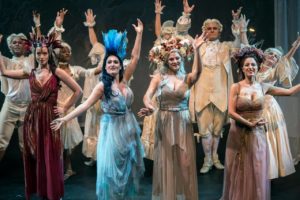
New York City Opera 2016-17 Review – Los Elementos: A Rare Spanish Gem Gets An Intimate Revival
By Greg MoomjyNew York City Opera first became famous for the re-discovery of forgotten works in 1966 when Beverly Sills sang in “Giulio Cesare,” even though the opera was not performed in its original format. However, City Opera can be given credit for re-starting the Baroque Revival that is still going on today. In its new incarnation, the company continues its tradition of reviving seldom heard pieces with special attention to Spanish-language opera. They began last year with performances of Daniel Catan’s “Florencia en el Amazonas” (1996). In 1994 Catan became the first Mexican composer to have an opera performed in the United States. This year, City Opera’s tradition of “Ópera en Español” continues with “Los Elementos” by Spanish composer Antonio Literes (1673-1747), written sometime around 1706.
Rediscovering A Rare Spanish Gem
“Los Elementos (The Elements)” has a very simple plot. Many musicologists believe that the opera was a prologue of a much larger work now lost. In it, the four elements, Fire (El Fuego), Water (El Agua), Air (El Ayre) and Earth (La Tierra), are all waiting for the dawn of a new day and they start arguing about who has the power to make the Sun rise faster. Time (El Tiempo) and Dawn (La Aurora) try to mediate. Their argument ends when the Sun rises and a new day begins. The structure of the opera follows the format of other works of the period where characters are allegories symbolizing the nobility. In this case, the Sun is the king’s right to assert his power over his subjects.
Spanish classical music is, unfortunately, a rarity primarily due to natural disasters like fires and earthquakes that destroyed the archives and libraries that held these collections. This is unfortunate because what remains is strikingly avant-garde for the period as Spanish composers were particularly innovative when it came to rhythm. Nonetheless, the majority of Baroque Spanish music was written for the church and accordingly there is very little opera. Because of the opposition to theater during Queen Margarita’s reign (1598-1611), it wasn’t until Philip IV’s marriage to Mariana of Austria in 1649 that music was allowed back into the royal courts.
An Intimate Setting
New York City Opera performed “Los Elementos” in Harlem Stage Gatehouse, a performing arts community center. From the outside, it looks like a medieval fortress that could’ve been Philip II’s El Escorial, his royal monastery in Madrid. The performance itself took place in a black box theater which brought the audience closer to the performers and heightened the intimacy of the work. The production consisted of digital images projected on white curtains that ranged from stars in the sky to the earth and water, to the sun rising over a forest. But of particular note was that before the opera began the audience got to see the original title page of the score of the opera which also helped put everyone in the mindset of the 18th century.
The costumes designed by Janet O’Neill were a mix of the Baroque and modern eras — they could’ve worked just as well in the context of the opera as they could’ve at the recent Met Gala. For example, the costume for Water was a blue Baroque gown but she wore a contemporary blue wig. The dress that Dawn was a wearing was a very modern gown with a slit down the middle while wearing a gold Venetian masquerade mask.
A Balanced Cast
The conductor, Pacien Mazzagatti, paid special attention to the strings but he also highlighted, when necessary the castanets, which really added to the Spanish flavor of the work. In terms of the vocal performances, everyone sang very well. Air, Samarie Alicea, had a very sweet and lyrical voice. Dawn, Magda Gartner, brought poignancy to her aria when she told the creatures of the Earth to have courage as they wait for the sun to rise. Fire, Kelsey Robertson, and Water, Chelsea Bonagura, both displayed an impressive vocal range in their multiple arguments with each other. However, at times, Water seemed to push herself too much. Fire, though, was an appropriately feisty coloratura. Her performance brought out the musical similarities between the fire from the fireplace, Le feu, from Maurice Ravel’s “L’enfant et les sortilèges” and this Fire (El Fuego). Time, Marco Nisticò, had a very strong bass voice which was even more thrilling given how intimate the theater was. Earth, Melanie Ashkar, had a very rich mezzo which was good but like Water, she occasionally pushed herself.
In general, it was a great performance and City Opera can congratulate itself on its success. Here’s to hoping that they continue to explore Spanish language opera.


